Corned beef is almost a thing of the past in Crete. This was the only kind available on the supermarket shelves, and there was a very small amount of shelf space allotted to it. On the other hand, there were quite a few varieties of canned luncheon meat on sale, containing all kinds of meat (beef, pork and chicken). Corned beef is neither cheap (this can cost 2.45 euro), nor does it come from Argentina any longer (it is French).
The can of corned beef reminded me of my parents. They liked the stuff enough to make a meal out of it during my youth. I couldn't understand why they liked it, as it resembled nothing of what my mother cooked for us. In fact, it looked quite repulsive. It was always packaged in that special can with a key on the side. On opening the can, you are faced with an oozing brown jelly fat wrapped around a dense sliceable mixture of pinky-red mince. On opening the can with that special key, the jelly would force the meat to slide out of the can when upturned. I remember we used to serve corned beef like this, straight out of the can, sliced up on a plate, and nothing more. It was considered a meal in conjunction with salad and bread, the cheap white resilient spongey pre-sliced stuff, with a zombie-like, yeasty odour and bleached and puffy crumb that we used to buy in NZ before the days of artisan bakeries. This 'meal' would be served on picnics, or when my mother had no time to cook, which was rare. What's more, it was always treated as a full and nourishing meal. It would be a long long time before I put two and two together; in fact, both my parents had died by the time I realised why they treated corned beef as a superior kind of salami.
I got six lean slices from the 200g can of corned beef. Half of them I fried in olive oil by flouring them first, while the other half of the mixture was added to a kolokithokeftedes batter (courgette fritters) and then fried in a similar way. Both patties were palatable - but would I bother to make this again?
My husband also remembers corned beef very well. There was one particular moment in his life where corned beef was in fact the only food available. After completing his studies at a local training centre for aircraft mechanics in the late 70s, he was then drafted for military duty. On arriving in Athens by overnight ferryboat, he took the train to Tripoli in the Peloponese. An army officer had been consigned to this journey, and his role was to take care of all the νεοσύλλεγκτοι, young men like himself, as they made their way to bootcamp. For most of them, it was their first time away from home, and the train journey was where they all ate their first army meal: a slice of cold corned beef, placed on a slice of stale bread. Husband, being unused to such coarse food served so roughly, threw his away, not because he didn't like corned beef, but because, as he explained to me, it wasn't cooked. He later discovered that he would have plenty of time to learn to eat cold corned beef: during training runs in the air force, each cadet would be given a slice of bread (this time, it was always fresh because there was a bakery in the camp) and a small can of corned beef to eat while they were away from the base. If they could manage to hold out a little longer, they would take their can back to the camp kitchens and eat it fried in slices.
*** *** ***
Corned beef became known to Greece during WWII. When the Nazis began confiscating people's food, the Greek people came to know hunger on a large scale. After the Nazis' departure, items like corned beef and other American food products were shipped to Greece through aid packages due to a local shortage of high energy food. Before the advent of supermarkets, not only was food expensive for the average Cretan, it was also difficult to come by so much variety. So corned beef was actually considered cheap and nourishing food, a handy and economical meat product that could be stored easily for a long time until needed.
My husband isn't the only curious person in the house. I was curious to find out why this kind of canned pork made such a sensation in the film "Christmas with the Kranks", starring Jamie Lee Curtis; apparently, Christmas just wasn't the same without this ham in their house (the shape of the can is the same as in the film, but I don't know about the texture).
I have never eaten corned beef since I left New Zealand, so I wondered how we were going to make use of the can that my husband bought. Due to the present ease of access in Crete to any kind of food that one's heart desires, combined with the abundance of fresh local food products, it was difficult to think of a moment when I would need to open a canned product to cook with.
My husband's food memories rest mainly with his mother's food. Although his family were considered poor, being the son of a taxi driver (and possibly also because he was an only child), quality food was always a top priority in their household. His father would go to the central town market, the Agora, and buy the biggest fish, which was never on display, because you had to be a 'special' customer for that kind of product. Still, corned beef made an appearance in his home. He remembers eating it often. Due to her proud Cretan spirit, his mother never served any food straight out of a can; this for her was a sign of slovenliness, γυφτιά. Similar to her recipe for canned Californian squid, she used corned beef in a cooked meal with a red sauce. According to my husband, he remembers eating this meal regularly while growing up.
You need:
1 can of corned beef (or pork, like the one I bought)
2 eggs
1 large tomato
1 medium onion
olive oil
salt and pepper
Heat some oil in a wide saucepan and add the finely chopped onion. Saute till transparent, then add the crumbled corned beef. Let the meat cook for a few minutes until it is coated well in the oil. Add the tomato, crushed as a puree, and stir it into the mixture. Season the corned beef with salt and pepper. Let the pan cook till most of the liquid has evaporated. Then add the two beaten eggs and stir them into the mixture. When the eggs have set, this casserole is ready to eat.
We had this dish served with a salad and some bread, but my husband also recalls that his mother used to cook corned beef from Argentina in this way, and serve it on pasta (spaghetti). My friend Laurene tells me that this could also be used as a pie filling, as she recalls eating in her youth.
This meal resembles sludge. I thought it would end up as the dog's meal. I was surprised that it was enjoyed by 3/4 of the family. I honestly don't think I really want to eat it again. During my husband's youth, the gap between the rich and the poor in Hania may not have been very wide, but even then, the 'not-haves' stood out like sore thumbs among the 'haves'; at times like this when fresh produce was not cheap enough for everyone to afford, this kind of meal was considered real food.
©All Rights Reserved/Organically cooked. No part of this blog may be reproduced and/or copied by any means without prior consent from Maria Verivaki.
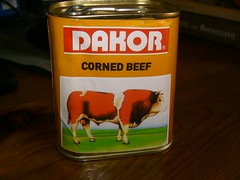
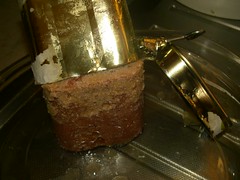

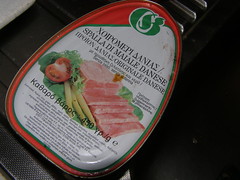
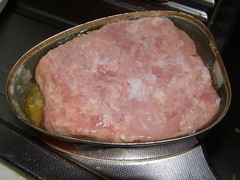
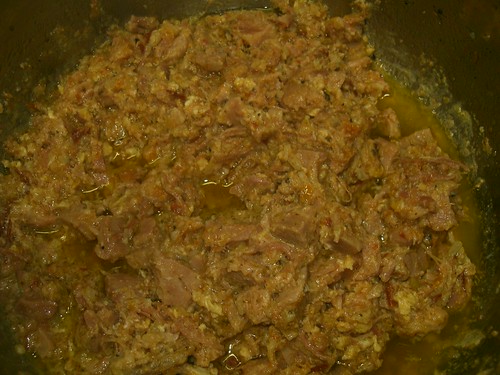
I can't stand the stuff. That or Spam or PEK 'chopped pork' and the canned ham in oval tins that my mother still regards as something of a luxury, and that my nephew refers to contemptuously as 'tinned pink'. All reminiscent of school dinners up to about 1975, and my mother's dislike of cooking and lack of interest in food.
ReplyDeleteThere are similarities here with SPAM in Korea, although it's still widely eaten. Koreans first developed a taste for American processed meats during the Korean war.
ReplyDeleteKoreans sometimes batter or flour slices of SPAM and pan fry them, it's based on traditional "jun" (battered or floured vegetables or proteins that are fried). I find ...this interesting because I am fascinated by the way different cultures adapt new ingredients.
This reminds me of the time that I spent several months exploring every nook and cranny of L.A. in search of "ethnic" markets. I started to notice corned beef everywhere. It was at the Filipino stores, the Nigerian store and the a store that sold some Jamaican food stuffs. I wondered what all these regions of the world had in common? Of course, it was the British.
My granddad would never eat ANY canned food... apart from corned beef! He was a very picky eater, but occasionally ate this. I actually like it, but it is way way too fatty to eat. Very very rarely, I'll eat it like this, with pasta just the way granddad did :)
ReplyDeleteI feel I should apologise on behalf of my nation for corned beef. It's disgusting. That said, if I had to choose between Spam or corned beef (under what kind of circumstances I can't imagine) I would choose corned beef. My mum used to buy 'posh' (?!) corned beef in slices from the cold meat counter. Equally disgusting. But I hand the prize for 'disgusting' to a friend of my husband, who used to make them Spam Curry when they were students.
ReplyDeleteThe Brits were in India too, but we never really developed a taste for corned beef, for obvious reasons (a very large number of, though not all, Hindus in India don't eat beef because of religious taboos).
ReplyDeleteBut I think in general, historical...ly Indians never had much of a taste for preserved meat - we don't have a very noteworthy sausage making tradition except in very few parts of the country.
I grew up with corned beef, but never from a tin. My mother would buy a piece of raw "corned" beef - it had been treated in a salt solution by the butcher. The single piece of beef would be placed in a large cooking pot with bay leaves, some golden syrup a few whole peppercords and water to cover. The meat would simmer away for an hour of so, then be lifted out to drain. By this stage the kitchen smelt disgustion.
ReplyDeleteIt would be served in hot thick slices with mashed potatoes and cabage boiled until it grey, sodden and flavourless. I loathed it all, especially being made to have the hot meat with english mustard.
Now, just a day latter, the cooled down meat, very finely sliced was delicious in salads or a meat platter aloungside of other treats for a relaxing lunch.
The tinned lot that have bad name here are those containing very fatty cuts of beef that were sold to the Pacific nations by the likes of my country,
If my dear Mum had removed all signs of fat from thinly sliced cold corned beef I'd have happily eaten it for my school day lunch, at last moving from me (aged 7)from eating only marlade sanwhiches because that was what Paddington Bear ate!
Perhaps for our parents it reminded them of their own childhoods and the war years of canned corn beef and SPAM. My mom loved to serve canned corned beef hash.
ReplyDeleteCanned corned beef is so disgusting. I remember the wonderful big pieces of corned silverside my mother used to cook for us, and I sure do miss it as we can only buy the very fatty corned brisket here.(well at least that is all I have found in the local supermarkets)
ReplyDeleteI never ate corned beef until I met Chris - his family at a fairly unimaginative "meat and potatoes" diet. He wouldn't even eat rice when I first met him. It's funny to see the effect his mother had on the family - his father's family (grandparents, aunts & uncles, cousins) all love a variety of foods, including seafood, like me; her and her children would sooner have a hot dog.
ReplyDeleteAnyhow he enjoys corned beef usually in a sandwich, with mustard. I'll eat it, but only if he grills the sandwich, or cooks the meat.
I don't know why my mother never served it to us, maybe she had bad memories of it (I know she never saw fresh fish growing up, so I imagine there was a fair bit of corned beef). What we did eat was "luncheon meat" - not Spam, we didn't get "brand name" luncheon meat, but Canadian brands like "Holiday" or "Kam". My father called it "meat for the war" and ate it with great relish - sometimes he'd open a can just for himself, and put it back in the fridge on a plate with a soup bowl over top to keep it fresh. We often ate it at lunch or supper - usually with some cheddar cheese and crackers. I know we ate it at supper but that's how I remember it best, as a snack. Or maybe on the side along with some "instant" powdered Lipton's chicken noodle soup. I don't keep it in the house, if only because I couldn't get through a tin by myself without getting sick of it.
Another common product which gets treated like corned beef is bologna/baloney (http://en.wikipedia.org/wiki/Bologna_sausage). It was considered an expensive (and therefore prestigious) import in 20th century Newfoundland, and Newfie children would gladly trade away the lobster sandwiches their mothers had packed for a baloney sandwich. Why? Lobster was common and ugly-looking, not particularly esteemed. It's so common there that fried baloney is called "Newfie steak". Other products designed for the long haul which are still popular in Newfoundland not because they're particularly delicious but because they've developed a taste for them are powdered milk, and hard tack (a rock-hard biscuit meant for sea voyages - you'd know it as "ANZAC wafers). We didn't grow up in Newfoundland, obviously, but Chris and I both grew up eating baloney, cold or fried in sandwiches. It's one of those things - like "meat for the war" that I associate with the leaner years of my childhood, so I tend to avoid them. If Chris has a craving for baloney or corned beef, fine, they go into the cart and I'll partake. But I don't buy giant logs of baloney to stash in the freezer like Chris' mother, or keep corned beef stashed in the cupboard. Although I do keep a store of "flaked ham" and "flaked turkey" alongside the canned tuna for making mayonnaise-based "salads" to fill sandwiches with, because they're easier to keep than than sliced deli meats...
Very interesting read Maria! I've only ever sampled spam-the canned variety and I clearly remember my father frying it up with eggs and serving it in a sandwich. I'd be curious to try your recipe with the courgette mix though!
ReplyDeleteAh, I remember canned corned beef- my mother used to break it up in diced potatoes and fry them together. Back in the 50's I thought it was really great. But I also liked Spam back then too. I'm so glad that my tastes have changed!
ReplyDeleteI had to laugh, Maria, at the meal you called "sludge". You may not want to eat it again, but it is fun to take a trip down memory lane isn't it? I enjoy recalling the foods I ate growing up, even if I can't stand to eat them anymore. Thanks for a great read! :)
My husband's parents were both children in Furnes during WWII -- today is actually the anniversary of the German occupation of the village. This story helps me to understand their life -- far removed from my American childhood. Thank you!
ReplyDeleteIf you ever cook it again try and make a corned beef hash served with poached or fried eggs on top. It's pretty good! Serve with toast. The first time I had it as a child, at a friend's house in the States I came home telling my mother I had eaten cake with an egg on top. Never had Spam and don't think I want to.
ReplyDelete